
Dubrovnik is a city in southern Dalmatia, Croatia, by the Adriatic Sea. It is one of the most prominent tourist destinations in the Mediterranean, a seaport and the centre of the Dubrovnik-Neretva County. Its total population is 41,562. In 1979, the city of Dubrovnik was added to the UNESCO list of World Heritage Sites in recognition of its outstanding medieval architecture and fortified old town.

The Acheron is a river in the Epirus region of northwest Greece. It is 52 km (32 mi) long, and its drainage area is 705 km2 (272 sq mi). Its source is near the village Zotiko, in the southwestern part of the Ioannina regional unit. The Acheron flows into the Ionian Sea in Ammoudia, near Parga.
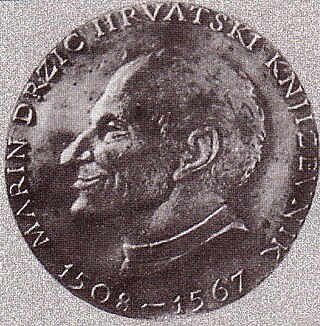
Marin Držić was a Croatian writer from Republic of Ragusa. He is considered to be one of the finest Renaissance playwrights and prose writers of Croatian literature.
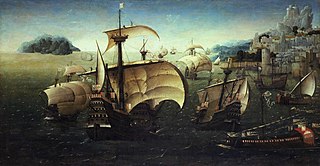
A carrack is a three- or four-masted ocean-going sailing ship that was developed in the 14th to 15th centuries in Europe, most notably in Portugal and Spain. Evolving from the single-masted cog, the carrack was first used for European trade from the Mediterranean to the Baltic and quickly found use with the newly found wealth of the trade between Europe and Africa and then the trans-Atlantic trade with the Americas. In their most advanced forms, they were used by the Portuguese for trade between Europe and Asia starting in the late 15th century, before being gradually superseded in the late 16th and early 17th centuries by the galleon.

Lopud is a small island off the coast of Dalmatia, southern Croatia. Lopud is economically the most developed of the Elaphiti Islands, and can be reached by boat from Dubrovnik, Trsteno, Orašac and Zaton. The island is famous for its sandy beaches, in particular the bay of Šunj. Lopud is the second largest island of the Elaphiti islands, between Koločep and Šipan. It is famous as the "island in the middle". It has an area of 4.63 square kilometres and its highest point is Polačica, 216 metres above sea level. It has 11.5 km (7 mi) of coastline, of which 1.2 km (1 mi) is sandy.
Francesco Maria Appendini was an Italian Latin and Italian scholar who studied Slavic languages in the Republic of Ragusa. The French invasion prevented him from returning to Italy, and he adopted Republic of Ragusa as his own country. He took it upon himself to investigate its history and antiquities.

The Republic of Ragusa was an aristocratic maritime republic centered on the city of Dubrovnik in South Dalmatia that carried that name from 1358 until 1808. It reached its commercial peak in the 15th and the 16th centuries, before being conquered by Napoleon's French Empire and formally annexed by the Napoleonic Kingdom of Italy in 1808. It had a population of about 30,000 people, of whom 5,000 lived within the city walls. Its motto was "Non bene pro toto libertas venditur auro", a Latin phrase which can be translated as "Liberty is not well sold for all the gold".

Cavtat is a village in the Dubrovnik-Neretva County of Croatia. It is on the Adriatic Sea coast 15 kilometres south of Dubrovnik and is the centre and the main settlement of Konavle municipality.

The House of Gundulić was a noble family of the Republic of Ragusa, considered one of the most prestigious families of the republic. It had origins in southern Dalmatia and Tyrol. The family´s motto is Tout ou rien.

The maritime republics, also called merchant republics, were Italian thalassocratic port cities which, starting from the Middle Ages, enjoyed political autonomy and economic prosperity brought about by their maritime activities. The term, coined during the 19th century, generally refers to four Italian cities, whose coats of arms have been shown since 1947 on the flags of the Italian Navy and the Italian Merchant Navy: Amalfi, Genoa, Pisa, and Venice. In addition to the four best known cities, Ancona, Gaeta, Noli, and, in Dalmatia, Ragusa, are also considered maritime republics; in certain historical periods, they had no secondary importance compared to some of the better known cities.
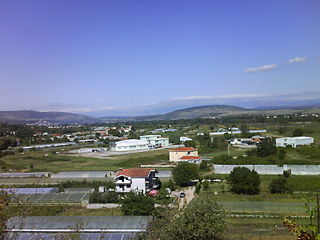
Gabela is a village in southern Bosnia and Herzegovina, 5 kilometres south of Čapljina and 4 kilometers from Metković, in Croatia. It is situated in the navigable lower course of the Neretva, off the major road linking the coast with the mountainous hinterland.
Argosy or The Argosy may refer to:

The Walls of Dubrovnik are a series of defensive stone walls surrounding the city of Dubrovnik in southern Croatia. Ramparts were built in the outlying areas of the city, including the mountain slopes as part of a set of statues from 1272. The existing city walls were constructed mainly during the 13th–17th centuries. The walls run an uninterrupted course of approximately 1,940 metres (6,360 ft) in length, encircling most of the old city, and reach a maximum height of about 25 metres (82 ft).

The House of Bona, or Bunić, is a noble family long established in the city of Dubrovnik.

The Giorgi or Zorzi were a noble family of the Republic of Venice and the Republic of Ragusa.

The House of Buća was a noble Serbian family that served the Republic of Ragusa, and one of the most important families to come out of Kotor. A cadet branch was admitted to the nobility of the Republic of Ragusa, another branch moved instead to Šibenik.

Paladino Gondola was a Ragusan diplomat and merchant, a member of noble Gondola noble family.
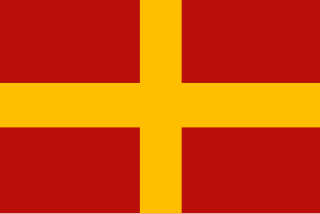
The Republic of Ancona was a medieval commune and maritime republic on the Adriatic coast of modern-day Italy, notable for its economic development and maritime trade, particularly with the Byzantine Empire and Eastern Mediterranean, although somewhat confined by Venetian supremacy on the sea. It enjoyed excellent relations with the Kingdom of Hungary, was an ally of the Republic of Ragusa, and maintained good relations with the Ottoman Empire. All these relationships enabled it to serve as central Italy's gateway to the Orient.
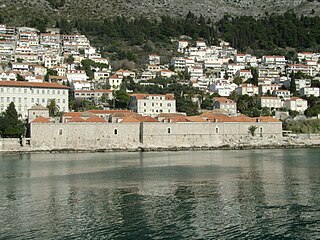
The Lazzarettos of Dubrovnik is a group of interconnected buildings located 300 meters away from the walls of Dubrovnik that were once used as a quarantine station for the Republic of Ragusa.















